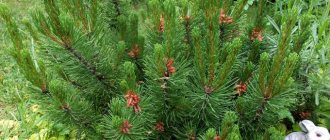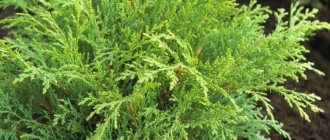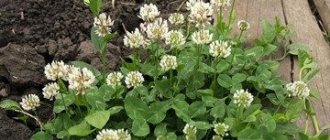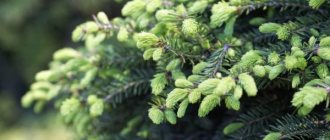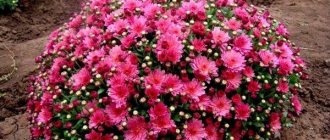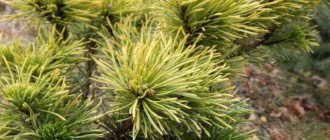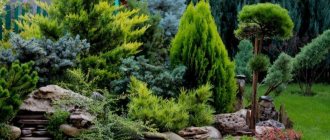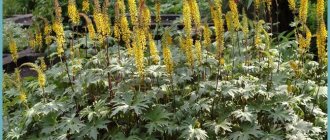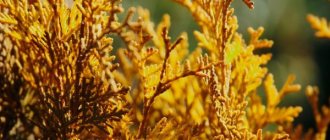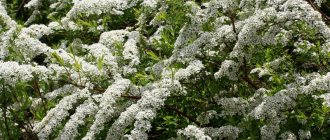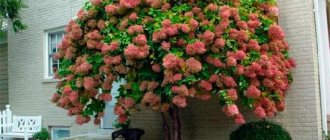Bushes and trees
1
400
Article rating
Kira Stoletova
Mountain pine Pug (Pinus mugo Mops) is a prominent representative of ornamental plants grown for landscape design of private plots and park areas. Coniferous trees are adapted to urban conditions.
Mountain pine Pug: how to care for a coniferous plant
Botanical characteristics
Pug pine is one of the dwarf evergreens.
Description:
- the crown has a regular spherical shape, formed by short shoots;
- young trees have a uniform color, dark green or blue-green, needle sizes are 2-4.5 * 2 cm, collected in bunches of 2 pieces, needles change every 3-5 years;
- on the shoots there are densely planted thin resinous buds - oval cones (1-2 cm), brown in color,
The culture is drought-resistant and easily tolerates lack of moisture. Winter-hardy, intended for cultivation in USDA climate zone No. 2, where temperatures drop to -45°C.
Description of the plant
Mountain pine Pug, in Latin Pinus mugo Mops, is a low-growing shrub whose height does not exceed 1.5-2 m.
A striking feature is the crown of the plant, which looks like a regular ball. It lends itself well to shaping, which played a big role when using it for landscaping.
The buds are densely located and have different dimensions, the needles are collected in bunches of 2 pieces. The needles are characterized by an emerald or dark green hue, the length does not exceed 4.5 cm. The crown change occurs in the 3-5th year of the crop’s life.
The cones are brown, ovoid. They reach 7 cm in size.
The root system is quite developed, but superficial and sensitive to soil compaction.
Growing regions
Easy care and good frost resistance allow pine to be cultivated in any climatic conditions. It can be grown in Moscow, the Moscow region and in central Russia.
Advantages
- Drought resistance (the plant can retain moisture in the soil due to the litter of pine needles in the near-trunk area);
- Resistance to air pollution;
- Frost resistance (USDA zone 2);
- Adaptability to temperature fluctuations;
- Easy to care for;
- Slow growth - every year the pine tree adds up to 4 cm in height;
- Low soil requirements;
- Resistance to gusts of wind.
Sources used:
- https://fermilon.ru/sad-i-ogorod/derevo/sosna-mops-vysota-i-opisanie.html
- https://fermoved.ru/kusty-i-derevya/sosna-gornaya-mops.html
- https://pro100ogorod.ru/kusty-i-derevya/sosna-gornaya-mops.html
- https://hvorast.ru/sosna/sosna-gornaya-mops
- https://stroy-podskazka.ru/sosna/vidy/gornaya-mops/
- https://idachniki.ru/design/zhivaya-izgorod/sosna-gornaya-mops-vysota-posadka-i-uxod-foto.html
Growing Requirements
The dwarf species can be planted both in open ground and in a separate container - a container.
The latter method is convenient because of its mobility: if necessary, the tree is moved to a new location.
When growing, it is worth considering that the conifer grows slowly, up to 2-8 cm per year, and branches heavily.
The optimal planting time is mid-spring (late April - early May) or autumn (late August - early September).
Selection of seedlings
It is recommended to purchase seedlings from nurseries, where they have already been grown and adapted to local conditions. Such planting material has a slightly higher price, but the chances of taking root are much greater.
Trees are sold in different forms:
- with an open root system, placed in a temporary area or with roots wrapped in film;
- with a closed root system, when each conifer is planted in a separate container in the soil mixture.
The second option is preferable.
When purchasing, the age of the seedling is of no small importance. It is better to buy young trees that are already 4-5 years old.
Site preparation
Pine loves sunlight
Almost any site is suitable for the dwarf Pug pine, but the tree grows worse in shaded areas. For full growth, sunny sides are needed.
Due to its well-developed, spreading root system, conifers can be planted on sandy and sandy loam soils, moderately dry or moist, even depleted in nutritional components.
Any soil acidity is acceptable, but it is better to choose an area with slightly acidic soil.
Composition of the soil mixture: turf, sand or clay, taken in a 2:1 ratio.
Landing technology
For planting, drainage is required, which is laid out with coarse sand, crushed stone or gravel, layer thickness - from 0.2 m.
Planting pits are formed 2-4 weeks before the expected date of planting seedlings at a distance of 2 to 4 m from each other.
The width of the hole should be 15 cm greater than the diameter of the root system, the depth should be from 0.7 m.
Coniferous debris from pine trees is added to the soil mixture to provide the plant with future symbiotic processes and fertilizers. Nitroammophoska (100 g per 1 planting hole) is suitable as a top dressing.
When transplanting, the root collar is left at ground level or slightly raised. The seedling in the new place is watered abundantly. During the first 5 days after planting, the young conifer should be covered from the sun with spruce branches or spandbond.
Features of the mountain pine variety Pug
Mountain pine Mini Pug has the following characteristics:
- Needles. The short needles are dark or blue-green in color. They form small bunches on the branches.
- Soil requirements. The plant is unpretentious and can grow in any type of soil. Pine gives preference to sand and gravel substrates enriched with humus.
- Need for light. Conifers grow well in high light conditions. When grown in shaded areas, plant development may slow down.
- Humidity requirements. Pine can withstand drought. A thick litter of fallen pine needles retains moisture in the soil, providing nutrition to the plant.
- Frost resistance. The tree is resistant to low temperatures and can grow in regions with harsh climates.
- Landing. Plants of this variety are planted in open areas with good lighting.
- Care and protection. In dry weather, sprinkling and soil moistening are required. As the soil density increases, loosening is necessary. The growth of shoots is slowed down by removing part of the growth. The same method helps to form a thick spherical crown.
- Purpose. The tree is used in the design of rocky gardens, containers, and alpine slides.
Rules of care
An adult and rooted pine tree is unpretentious to care, but young seedlings at the initial stage need to create all favorable conditions for growth and development.
Watering
Watering is carried out once a week. Moisten along the perimeter of the planting hole, avoiding direct contact with the tree trunk. Additionally, during the hot season, the crown is sprinkled.
Top dressing
Young conifers are fed during the first 2 years after planting.
Subsequently, an adult pine tree does not need additional nutrition, taking all the necessary components from the soil thanks to its developed, widely branched root system.
For fertilizing, universal fertilizer complexes designed for coniferous trees are used.
Mulching and loosening
The tree trunk circle is mulched immediately after planting the seedling. Peat is suitable as mulch; the minimum layer is 5 cm. In the future, it is not removed, but is gradually mixed with the soil.
Ephedra is sensitive to soil compaction, so loosening is carried out regularly, especially when an earthen crust forms after precipitation or watering. Loosen the soil around the perimeter of the planting hole.
Crown formation
The plant is rarely pruned, because the natural feature of this variety is a correctly growing crown.
Pruning is done more often for sanitary purposes, removing dried and frozen branches and with the intention of slowing down growth and increasing density.
When forming the crown, the number of annual shoots is reduced.
Winter protection
Young plants must be protected from frost
Mature pines are resistant to frost and wind. In the first 2 years after planting in open ground, young seedlings require protection from the cold for the winter. For these purposes, the roots are covered with spruce branches.
It is especially important to provide winter shelter for seedlings planted in a new location in the fall.
Conifers open at the onset of spring, when constant warm weather sets in and there is no risk of return frosts. Watering with melt water helps speed up the process of adaptation and recovery of the plant after winter.
Mulching and loosening the soil
The purpose of mulching is to improve soil properties and protect the root system. Mulch also helps prevent weeds from appearing. It is recommended to use peat in a 6 cm layer as a covering material.
Due to the high requirements for air permeability, the soil must be loosened as a dense crust forms on the surface, while simultaneously removing weeds. However, such work is not carried out too often to avoid damage to the sensitive roots of the pine tree.
Reproduction methods
Mountain pine is propagated in one of three possible ways.
- Seeds. They are germinated in separate containers or by sowing directly into open ground. Mandatory stratification is required before planting. The best time is spring. Disadvantage: the maternal qualities of the variety are often not preserved.
- By cuttings. The collection of shoots is carried out from annual conifers, cutting off along with the heel bark. Initially, the cuttings are soaked in a growth accelerator for 12 hours, then kept in ordinary water for 3 days and only then planted in open ground. A cutting planted in autumn takes root within a year, and a cutting planted in spring takes 6 months.
- Vaccination. Graft mountain pine onto trees (4-5 years old). The grafting method allows you to pass on most maternal qualities.
Where and how to raise a Pug?
When choosing a site for planting Pug pine, take into account the following nuances:
- Possibility of growing next to other plants. The tree draws moisture from the soil, so other crops cannot grow near it. In addition, the soil under the pine tree is constantly covered with pine needles. The optimal distance from other plants is 10 m.
- Proximity of the site to the foundation. The tree has a powerful root system, so it must be planted at a distance of at least 5 m from the base of the house. If the foundation is not monolithic or columnar, pine roots can destroy it.
Resistance to diseases and pests
Mountain Pug pine is resistant to the main diseases found in conifers and is rarely affected by pests. More often, the crown of young pines suffers from sunburn.
If the rules of care are not followed, the conifer may develop fungal diseases.
- Schutte. The primary signs are a change in the color of the needles from green to brown, drying out of the branches and the appearance of a white coating, similar in appearance to a cobweb.
- Scleroderriosis. The buds die off, followed by drying out of the entire branch.
- Seryanka. It appears as a red coating on the needles.
Treat a fungus-affected tree by spraying it with copper sulfate-based products, after removing the diseased branches. As a preventative measure, spring treatments with solutions containing sulfur are used.
Description of the mountain variety of pine Pug, planting and caring for the plant
Mountain Pug pine is an unpretentious and attractive coniferous plant. Trees propagated by several methods have virtually no disadvantages. This is the best type of dwarf evergreen plant that forms a lush, rounded crown.
Garden decoration
This plant is simply irreplaceable in garden landscape design. It can be used to decorate stone gardens, and even to decorate rocky slopes. In addition, many people plant dwarf pine around the perimeter of the yard to create hedges or multi-tiered compositions of various shapes . From pine on a trunk you can make a real mini-garden on an open loggia or balcony.
To summarize, we can say that mountain pine “Pug” is perfect for decorating a site and for decorating a small winter garden . The only thing that will be required is to look after her more diligently for the first few years. The rest of the time, the pine will grow on its own and will not require too much attention.
To learn how to plant a mountain pine and properly care for it, watch the following video.
Practical use
The main use of Pug pine is in landscape design. The tree is grown to decorate rockeries, rocky areas and create alpine slides.
Mini-conifers on a trunk are used to decorate balcony loggias and indoor winter gardens.
A plant with a decorative flattened spherical crown. The tree is dwarf; in 10 years it reaches a height of 40 cm. Light shoots stand out against the background of dark green needles.
A plant with a decorative flattened spherical crown. The tree is dwarf; in 10 years it reaches a height of 40 cm. Light shoots stand out against the background of dark green needles. The coniferous plant does not attract pests, so there is no need to additionally protect it from insects.
Description of mountain pine Pug
Externally, the plant resembles a slightly flattened ball. Its distinctive feature is that the tree grows almost equally in width and height. It lends itself well to pruning and shaping. The dwarf shrub of the Pug subspecies grows slowly - over the year the size of the pine tree increases by only 2 - 4 cm. Its main advantages:
- resistance to frost and wind;
- does not require a lot of moisture;
- tolerates polluted air well;
- has low requirements for soil, conditions, and care.
The full Latin name is Pinus mugo Mops. The plant reaches a height of 1.5 meters, including small shoots. The color of the needles varies - from green with blue to deep emerald. Needles are replaced every 3-5 years.
The cones of the Pug variety are brown, egg-shaped, from 2 to 7 cm long. The buds are resinous and grow densely. The roots of the mountain shrub form a large branched network closer to the soil surface. Thanks to this, Pug pine holds up well on inclined surfaces and alpine slides.
Landing technology
Planting of crops is carried out by transshipment, which ensures the preservation of the root system.
The chronology of the process is as follows:
- It is recommended to lay a drainage cushion 20 cm high at the bottom of the prepared hole. Gravel, crushed brick, and river sand can be used as material.
- A soil mixture is poured on top, which must contain turf and sand/clay in a 2:1 ratio. It is allowed to use a ready-made substrate.
- Then the seedling is transported to a permanent place so as not to damage the integrity of the earthen ball and the roots of the plant. All that remains is to add more soil (the neck is at surface level) and water generously. If several specimens are planted, maintain a distance between them of 1.5 to 4 m.
Additionally, it is allowed to add nitrogen/complex fertilizers, compost or manure to the soil.
In the next 4-5 days, the plant should be shaded with spunbond or spruce branches, because the first few years after transplantation the tree is sensitive to direct sunlight.
Pine's unpretentiousness and resistance to external factors manifests itself only in adulthood, so the young plant must be provided with proper care, which is expressed in standard agrotechnical work - weeding, loosening, systematic watering, fertilizing.
Planting and caring for mountain pine Pug
Choosing the right place to plant is key. The area should be well lit. In the shade, the mountain shrub grows slowly, the color of the needles is dull, barely green. In such conditions, the likelihood of illness is high.
The soil for Pug pine should be light, well-permeable to air and moisture. The acidity can be any, although a slightly acidic environment is tolerated better by the plant. If the soil on the site is heavy and dense, it is necessary to create an additional drainage layer - a mixture of small stones and sand is poured on top of the soil (layer thickness is at least 20 cm).
Pug pine tolerates polluted air well, so it is often used for urban landscape design. The shrub easily adapts to temperature changes, snow, heat, heavy rain and wind. In hot, dry weather, additional watering is necessary. This unpretentiousness allows you to grow the plant in central Russia, Moscow, and the Moscow region.
Preparing seedlings and planting area
The optimal time for planting young mountain shrubs is the second half of spring and early autumn. In order for Pug pine seedlings to take root in the new soil and temperature conditions, they must be prepared in advance.
You can buy ready-made seedlings in regular stores or specialized stores. The second option is better - in such places, the conditions of keeping and growing are, as a rule, close to ideal. Mountain varieties from nurseries suffer less disease and grow stronger and more resilient.
Before purchasing, choose one of the possible root systems:
- open - the plant is either placed in a temporary area of the store, or the roots are covered with film;
- closed - each shrub is grown in a separate pot.
A plant from a pot tolerates being planted in a new place better, takes root and adapts faster. Young trees are chosen - the age of the seedling should be less than five years. Carefully inspect the roots and needles - there should be no rot or damage on them.
Possible pine diseases
Mountain Pug Pine is not very susceptible to disease, but there are some weather conditions and vectors that can cause harm.
After winter cold, a weak plant can catch the fungus Schutte . In this case, the needles darken and the branches dry out after a whitish coating appears. The reasons may be a small amount of moisture or dense planting. The entire appearance of the plant deteriorates, it loses its needles and becomes bald.
Scleroderriosis leads to the death of the buds and the death of the entire branch. In this case, urgent pruning of the affected part of the plant is necessary.
Among the pests, aphids can be identified, which can be eliminated using special means. To avoid possible diseases, it is necessary to follow the rules of planting and care.
Mountain Pug pine is used in landscape design and does an excellent job of decorating the area. By observing all the requirements for cultivation, this plant can delight everyone with its appearance for a long time.
How to properly grow mountain pine Pug: Propagation by cuttings + Video
There are plants that are bred specifically for use in garden design.
Thus, mountain Pug pine is used to decorate personal plots. This low-growing shrub fits well into the environment, and it also smells pleasant. When growing this pine, you need to carefully choose the soil; in the future, problems should not arise. The survival rate of Pug pine in Russia is good, so its use has gained great popularity. The shape of the pine tree is voluminous and spherical, it can be up to 1.5 meters in height, and reaches the same dimensions in volume. The appearance is easily formed by pruning. Over the course of a year, the Pug pine gains a maximum of 8 cm in height. The buds, covered with resin, are densely located on the branches, their length is 2 cm. The conifer needles are rich green in color, with an emerald tint, they are about 5 cm in length. Every 3-4 years the needles fall off , being replaced by a new one. The roots of mountain pine are branched and do not respond well to heavy, dense soil.
Rules for caring for Pug pine and preparing for wintering
Caring for Pug pine includes the following activities:
- Watering. Mountain conifers, when grown under normal conditions, do not need to increase soil moisture. In hot and dry weather, the tree needs to be watered periodically. In late autumn, the soil under the seedlings is also abundantly moistened. This reduces the chance of getting a sunburn.
- Feeding. In the first 5 years after planting, fertilizers are applied annually. The plant needs minerals. Complex fertilizers are introduced in the amount of 50 g per 1 seedling. If the soil was fertilized during planting, nutrients are added only the next year. An adult tree does not need additional feeding; it receives nutrition from the coniferous litter.
- Pruning. It is not necessary for the normal life of a pine tree, but the formation of branches helps give the plant an attractive appearance. In spring, 1/3 of the branch length is removed. This is done by hand, carefully breaking off the shoots. Parts of the pine tree affected by the disease are also removed.
- Preparing for winter. Young seedlings are covered with spruce branches in late autumn. This helps protect the pine from frost and sunlight. Shade the plant by covering it with burlap. Do not use plastic film for protection. This leads to the development of fungal diseases. Mature pines do not need special preparation for winter.
Selection of seedlings and their planting
It is best to buy seedlings in specialized nurseries. After all, they are sold there already fully adapted to life. Seedlings that have been grown for 5 years are best suited for this. Of course, their price will be a little higher than in spontaneous markets, but their chances of survival are also much greater.
Seedlings can have an open root system or a closed one. The former are placed in open ground, while the latter are planted in separate containers.
Such plants can be placed in almost any area, but it is better to avoid those that are too dark. For the plant to grow and develop, it will need a lot of sun. Therefore, it would be correct to plant the mountain pine “Pug” in a place where it will have enough light and warmth.
Since the root system of the Pug pine is well developed, it can be planted even in sandy soils. In this case, the acidity of the soil can be any. The soil for planting may consist of coarse sand or fine gravel. In addition, you can add some fallen pine needles to it.
First you need to dig a hole. Its width should be 15-16 centimeters larger than the size of the root system, and the height of the hole should be about 70 centimeters. They dig it up in advance, 14-21 days before planting. The distance between seedlings should be at least two meters. As a fertilizer, you can add a little nitroammophoska to the hole, up to 100 grams per hole.
After this, the seedling needs to be installed in the middle of the hole and covered with earth. Its root collar should be at ground level. After this, the plant must be thoroughly watered and the ground around it covered with spruce branches.
An adult plant does not require special care, but a young seedling needs to be given a little attention.
Watering
First of all, you need to make sure that the plant receives the required amount of moisture. It is best to water around the perimeter of the entire hole, trying to do it very carefully so that the water does not get into the circle around the trunk. When it is too hot, you can water the crown of the tree by spraying water on it.
Fertilizer
The plant needs to be fed in the first 2 years after planting. Next, the mountain dwarf pine will be able to feed on its own, extracting all the necessary useful components from the soil in which it grows.
There are special complex fertilizers designed for coniferous plants.
Mulching
For the first time, this is done immediately after planting the seedling in the ground. You can use peat or ephedra as mulch. The layer must be at least 5 centimeters. After this, you don’t even have to remove the mulch, but simply mix it with the soil. In addition, after each watering it is necessary to loosen the soil around the tree as much as possible.
